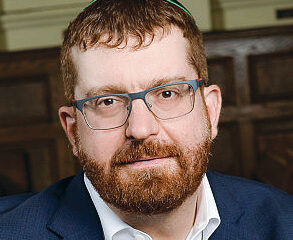Dor Hadash: family learning program aimed toward a new generation
Dor Hadash
Michelle Tedford
Special To The Dayton Jewish Observer
Andrea Liberman is an artist. When asked to illustrate a healing hero, the 9-year-old used a bright pink marker to trace an outstretched hand tipped with purple fingernails, dropping tzedakah in a box.
“I actually learned a new thing I didn’t know about heroes,” she said. “When people give money like tzedakah, that’s a way of being a hero and saving lives.”
The art activity was part of the eclectic educational programming that distinguishes Beth Abraham Synagogue’s Dor Hadash — New Generation — from traditional Jewish learning.
 Dor Hadash is an intergenerational exploration of Judaism. In its second year, it aims to create a sense of community among families with children in kindergarten through eighth grade.
Dor Hadash is an intergenerational exploration of Judaism. In its second year, it aims to create a sense of community among families with children in kindergarten through eighth grade.
Rabbi Bernard Barsky, Beth Abraham’s spiritual leader, said Dor Hadash was created to enrich a largely senior congregation.
“We were really looking to the younger families with children and toward integrating them into a community, a family, and … thinking of them as the new generation of Beth Abraham,” he said.
In discussions about the Dayton Jewish School, the supplementary religious school of Beth Abraham Synagogue and Beth Jacob Congregation, Barsky learned that families welcomed additional religious programs that would tie them more closely with Beth Abraham.
He knew the approach needed to be innovative and the focus had to be on the entire family, a way to combat the modern American Jewish reality of “pediatric Judaism” and the end of religious education at age 13, he said.
To prepare interactive lessons, Barsky enlisted the help of longtime educators Lynda A. Cohen and Candace R. Kwiatek.
Last year, Dor Hadash taught Judaism through the lens of symbols. This year, the theme is heroes.
“It’s a way to pull people in by coming at Judaism … in a little bit of a different way,” Kwiatek said.
Dor Hadash intertwines history, life events, ethics and issues families are addressing in the home, she said.
The program begins with a meal where families say brachot (blessings) before the meal. The group then separates by age, with children learning through reading, storytelling, films and other activities.
Parents discuss the same topics with the rabbi. The families then reconnect for a final activity or presentation.
The adults use a rabbinic text as a starting point for sharing practical information on how to integrate Judaism into family life.
“That kind of conversation with parents is one of the most important things you can teach families,” Barsky said.
In March, the family activity featured Beth Kolotkin dressed up as Ima Raskal, a hospital clown who heals the souls of sick and dying children through laughter.
Kolotkin was an example of a healing hero, the theme for that day’s session.
 She entertained the families, but had a real show-and-tell lesson about how a person can help even the terminally ill.
She entertained the families, but had a real show-and-tell lesson about how a person can help even the terminally ill.
“A hero is one who has great courage,” said Kolotkin, who told how she puts fish stickers on children’s IV bags and blows them a bubble bath to make them smile.
“You go in, and the children tell you what they want on their tombstone, and you listen and you go home and cry. But you leave them laughing.”
In Dor Hadash, children learn heroes befriend lonely classmates and help feed the hungry.
Cohen said, “They learn — how do we define our heroes? Who are the Jewish heroes? What do memories have to do with heroes?”
They also learn to incorporate teachings into everyday life. Each family received The Book of Jewish Values by Rabbi Joseph Telushkin. The 365 chapters give concrete ways to incorporate Jewish ethical values into daily life.
Last fall, Dor Hadash received the United Synagogue of Conservative Judaism’s Solomon Schechter Silver Award for Synagogue Excellence in Family Education.
Barsky said Dor Hadash, which includes a seven-year plan, is the start of an educational program he hopes will attract more families to the congregation.
This year, nine families — nearly all of those at Beth Abraham with school-age children — participate. The last heroes session will be held May 19.
The Libermans are one of many families who returned to the program for the second year. Scott Liberman, father to Andrea, said the new curriculum encourages the families to continue to learn.
“It’s good for kids to see their parents learning at the same time,” he said. “When we were told to go to Sunday school, we didn’t learn that this is for our own good. This way, the kids learn (that) the learning continues into adulthood.”
During the March session, Andrea also learned that she is a hero.
Like the rest of the families, she and her father emptied their pockets of coins to contribute to Dayton to Darfur, a program to help end genocide in Sudan, Africa.
They gave tzedakah and, in a future session, will report what they have learned about Sudan.
© 2006 The Dayton Jewish Observer





